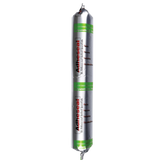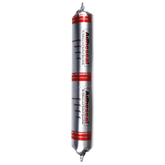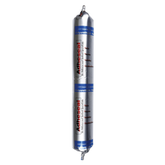
Sunstate Sands F6 & F8 Silica Sand: Technical Overview
Sunstate Sands Bundaberg Silica Sand is an exceptionally pure quartz sand (≈ 99.8 % SiO₂) mined from the Coonarr deposit near Bundaberg, Queensland. The mine’s natural gradation delivers material from below 250 microns to 5 mm, allowing tight control over texture and application performance.
The resource is graded into two primary products – F6 Foundry Sand and F8 Fine Sand – each engineered for specific industrial and construction applications requiring consistency, purity, and chemical stability.
Core Features & Specifications
- Exceptional Purity: ≈ 99.8 % SiO₂ with trace Al₂O₃ and Fe₂O₃; no Ca, Mg, K, Na detected.
- Two Graded Options: F6 Foundry Sand for industrial and epoxy applications; F8 Fine Sand for coatings and grouts.
- Consistent Particle Size Control: Natural gradation allows precise size separation or custom blending.
- Clean White Appearance: Visually bright and chemically inert for architectural use.
- Available Formats: Bulk silo, tanker or tipper distribution, 20 kg bags and bulk bags for logistics efficiency.
The Sunstate Sands Advantage
- Certified analysis by Australian Laboratory Services for verified purity and grading consistency.
- Chemical and physical properties enable use across foundry, construction, and industrial markets.
- Natural gradation minimises processing energy and supports sustainable supply chain objectives.
- Reliable Australian supply chain from Bundaberg with bulk and packaged options nationwide.
Applications in Practice: Trade Scenarios
F6 – For Foundry Operators and Epoxy Flooring Contractors
Maintaining mould integrity and thermal stability in high-temperature foundry operations or achieving consistent epoxy broadcast finishes without dust contamination.
Use F6 for its clean, controlled grading and low residual fines. It provides stable thermal conductivity in foundry moulds and uniform texture when broadcast into epoxy resins for industrial floors.
Store F6 in a dry environment to preserve bulk flow. When used in resins, broadcast evenly within 30 minutes of application for consistent bond and colour uniformity.
F8 – For Coating Manufacturers and Tilers
Ensuring a uniform fine texture and colour stability in grouts, adhesives, and textured coatings without impurities that affect binder performance.
F8 is kiln-dried and precisely graded for smooth dispersion in cementitious and polymer systems. Its low iron and organic content ensure optimum finish quality in decorative and industrial applications.
Always stir pre-mixed coatings thoroughly before application to maintain even sand suspension. Blend with coarser grades for anti-slip finishes as required.
Frequently Asked Questions
What are the differences between F6 and F8 silica sand gradings?
F6 Foundry Sand features a coarser, controlled grading ideal for foundry moulding, industrial casting and epoxy flooring. F8 Fine Sand is a kiln-dried, finer fraction used in textured coatings, grouts, adhesives and dry-mix fillers where smoothness and uniform dispersion are required.
What is the chemical composition of Sunstate Sands silica sand?
The sand contains approximately 99.8 % SiO₂ with trace Al₂O₃ and Fe₂O₃. No calcium, magnesium, potassium or sodium are detected, confirming the absence of shell or coral contaminants. Independent testing by Australian Laboratory Services (NATA) verifies this purity.
What packaging options are available for F6 and F8 sands?
Both grades are available in 20 kg bags, bulk bags and via bulk silo, tanker or tipper distribution. F6 Foundry Sand is typically stored in silos for high-volume industrial supply, while F8 Fine Sand can be packaged for both manufacturing and trade applications.
Can the two grades be blended for specific textures or performance?
Yes. The natural gradation of the Coonarr resource allows custom blends between F6 and F8 to achieve tailored texture profiles or specific flow characteristics in coatings, flooring, or composite systems.
Is moisture content controlled before dispatch?
Yes. Each batch is kiln-dried to a low-moisture specification to prevent clumping, segregation or density variation. This ensures accurate batching and uniform mixing in epoxy, grout and dry-blend production lines.
Applications & Benefits
| Application / Use Case | Key Benefit | Primary Trades |
|---|---|---|
| Foundry moulding and casting (F6) | Exceptional cleanliness and grain uniformity for stable mould compaction, high thermal conductivity, and reduced casting defects. | Foundry operators, metal casters, industrial engineers |
| Epoxy flooring broadcast systems (F6) | Uniform particle distribution ensures even texture and slip resistance; compatible with all major epoxy primers and coatings. | Flooring contractors, industrial coaters, resin applicators |
| Textured coatings and renders (F8) | Fine grading delivers smooth texture, bright whiteness and colour stability for architectural finishes. | Painters, renderers, coating manufacturers |
| Grouts and construction adhesives (F8) | Improves body and workability of cementitious and polymer systems while maintaining flow and strength consistency. | Tilers, builders, adhesive manufacturers |
| Dry-mix filler and composite manufacturing (F8 or blended) | Chemically inert, moisture-controlled filler enhancing density and stability of engineered mixes. | Manufacturers, composite fabricators, pre-cast producers |
| Custom blended industrial sands (F6 + F8) | Tailored grain profiles for specialised applications such as non-slip surfaces, resin infill, or textured membranes. | Specifiers, material engineers, production chemists |
Applying Sunstate Sands F6 & F8: Enhanced Protocols & Best Practices
-
Step 1 – Surface Preparation
Ensure all surfaces or moulds are clean, dry, and structurally sound. For concrete or screeds, mechanically remove laitance, grease, or contaminants. For foundry work, ensure mould boxes are dry and free from residual binder or release oils.
For F6 Foundry & Epoxy Use
Blow off fine dust and moisture before sand introduction. In epoxy flooring, confirm moisture content is below 75 % RH prior to resin application.
For F8 Coating & Grout Use
Clean substrate thoroughly. Apply primer if required on dense or sealed surfaces before adding F8-based material.
Timing: Allow primer or surface prep materials to fully cure (minimum 4 hours, or as per binder instructions) before sand application.Pro Tip: Temperature and humidity affect curing—plan applications in early morning or late afternoon to avoid flash setting or condensation issues. -
Step 2 – Sand Application
Select the correct grading and apply using suitable techniques to achieve uniform distribution and bonding.
F6 – Foundry & Epoxy Flooring
Broadcast F6 sand evenly over wet epoxy primer or base coat at approximately 2–3 kg/m². Allow to cure, then vacuum or sweep excess before topcoating. For foundry applications, ensure consistent compaction and pattern integrity before casting.
F8 – Coatings, Grouts & Adhesives
Incorporate F8 sand directly into dry-mix formulations or blend with wet binders under controlled mixing. Maintain mixing speed below 300 rpm to prevent dusting or segregation.
Timing: For epoxy floors, broadcast F6 within 30 minutes of resin application. For grouts and adhesives, use F8 within pot life for best consistency.Pro Tip: Use clean, dry application tools. Always check particle distribution under good lighting to confirm even coverage before final curing. -
Step 3 – Curing & Finishing
Allow system to cure under recommended environmental conditions. Avoid early exposure to water, vibration or traffic until full cure is achieved.
For F6 in Epoxy Systems
After full cure, remove excess sand by light vacuum. Apply topcoat for sealed finish or slip resistance as specified.
For F8 in Dry-Mix Systems
Ensure curing under stable humidity and temperature for consistent finish. Do not retemper with water once mixed.
Timing: Full cure typically within 24–48 hours depending on temperature, binder type and system thickness.Pro Tip: Always maintain curing conditions within manufacturer’s recommended temperature range (10–35 °C) for consistent surface results.
Limitations & Safety
Product Limitations
Safety & Handling Requirements
Personal Protective Equipment
Wear approved P2 respirator or equivalent when handling dry material to avoid inhalation of respirable crystalline silica dust. Use safety glasses or goggles, nitrile-coated gloves, and long-sleeved clothing to minimise skin and eye contact.
Ventilation Requirements
Operate in well-ventilated areas or use local exhaust extraction when transferring or blending dry sand. Avoid creating airborne dust during loading or mixing. Use wet-suppression or vacuum systems where possible.
Fire & Handling Precautions
Non-combustible mineral product. Avoid contamination with flammable materials or incompatible chemicals. Store sealed and off the ground to prevent moisture ingress and cross-contamination.
Emergency First Aid
Seek medical attention immediately for any persistent symptoms or serious exposure to respirable crystalline silica.
Sunstate Sands F6 & F8 Application Guide
F6 – Foundry & Epoxy Flooring Applications
For foundry moulding, ensure all patterns and mould boxes are clean, dry, and free from oil or residual release agents. For epoxy floor systems, concrete surfaces must be sound and cured (28 days minimum), with laitance and contaminants mechanically removed. Vacuum clean immediately prior to resin priming or broadcast.
Apply Adheseal Epoxy Primer System to prepared concrete, then broadcast F6 sand evenly onto wet primer or base coat to create a mechanical key. No primer is needed in metal or sand mould foundry work where F6 acts as the primary mould aggregate.
Adheseal Epoxy Primer SystemF8 – Textured Coatings, Grouts & Adhesives
Ensure all substrates are clean, dry, and free of oil, dust or efflorescence. On cementitious surfaces, remove loose particles by light grinding or brushing. Verify moisture content is below 75 % RH before mixing into epoxy or cementitious systems.
Use Adheseal Primer 2001 on low-porosity concrete and masonry before applying grouts or adhesives containing F8. For architectural texture coatings, primer may not be required if sand is pre-blended into a compatible binder system.
Adheseal Primer 2001Custom Blends & Special Applications
When using custom mixes of F6 and F8, store in sealed dry conditions to avoid moisture absorption. Blend mechanically using a low-speed mixer to ensure even particle distribution before adding binders or resins.
Confirm compatibility with the manufacturer’s binder or resin before final application. For high-adhesion systems, pair with Adheseal Primer 50A for superior wetting and bond stability.
Adheseal Primer 50A- Choosing a selection results in a full page refresh.





